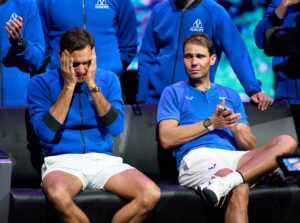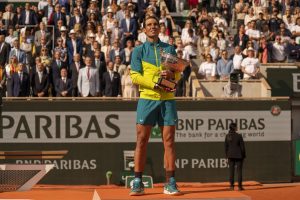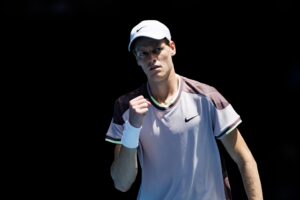The two end-of-season tournaments on the men’s tour – the NextGen Finals for the best Under-21s and the ATP Finals for the eight highest-ranked men in the world – do not just mark the end of one season but more importantly point the way forward to the future for men’s tennis. That may be true this year more than ever, because the triumphs of Jannik Sinner at the NextGen Finals and of Stefanos Tsitsipas at the ATP Finals respectively suggest that men’s tennis has not just one potential superstar in waiting but two.
It is now more than a week since Sinner won the NextGen tournament in Milan, but if anything the scale of his achievement has only grown in that time. It was not just the fact that he won in his native Italy after only gaining entry to the tournament as a wild card, but the fact that he won in such a dominant manner. Despite being, at only 18, comfortably the youngest player in the tournament, he seized his opportunity with both hands, winning his first two pool matches to reach the semi-final, then beating Serbia’s Miomir Kecmanović in that semi before dispatching the top seed and favourite, Australia’s Alex de Minaur, in straight sets (albeit the shortened seven-game sets used in the NextGen event) in the Final.
No less eminent an observer than Chris Kermode, the outgoing President of the ATP, has said of Sinner that he has never seen anyone hit a tennis ball harder, and that is despite the young Italian having a relatively slight build. However, what was arguably even more impressive than Sinner’s spectacular timing in striking a tennis ball is his frankly extraordinary ability to cope with all the attention and pressure coming his way. That was evident throughout the whole tournament as he proved himself to be the absolute antithesis of all the supposed “Italian” traits of being emotional or even hot-headed. He was the very model of composure, both on and off court, taking everything in his stride even as he strode to the very top of the young man’s game.
There is currently an advertisement in Britain with the tagline: “Old can be ambitious. Young can be wise.” The copywriters might have had Sinner in mind, because the over-riding impression that he created after winning the NextGen was that he was that rarest of things, a wise 18-year-old. Not only was he faultlessly polite and grateful to his opponent, the event organisers, the sponsors and all the fans but he graciously declined the requests of his fellow Italians to join the country’s Davis Cup team in Madrid this week to concentrate instead on his own continuing development as a player. And the fact that only a week after winning the NextGen he won another tournament, this time a challenger in Ortisei (also in Italy, but a world away from the glamour of the NextGen in Milan), shows that he is clearly capable of competing, and winning, on any stage, however big or small.
Of course, injury is an ever-present threat for Sinner, as for any young tennis player, as demonstrated by the case of South Korea’s Chung Hyeon, who won the inaugural NextGen event in 2017. Initially, Hyeon carried that forward momentum into the next season by beating Novak Djokovic at the 2018 Australian Open and reaching the semi-finals. Since then, however, he has struggled with a succession of debilitating injuries and his current ranking (outside the world’s top 100) is a reminder that youthful success, even at the NextGen Finals, is no guarantee of long-term success.
Nevertheless, the suspicion remains that if anyone can remain level-headed about his breakthrough triumph, which includes maintaining the rigorous mental and physical preparation that is a prerequisite for any tennis pro, it is Sinner. And with Italy seemingly in the vanguard of men’s tennis right now, with Matteo Berrettini qualifying for the ATP Finals and Turin the next host city for that event from 2021 onwards, there is every chance that Sinner could become, in time, the most successful Italian male tenni player since the great Nicola Pietrangeli, who won successive French Opens nearly sixty years ago.
Of course, Sinner has an extremely hard act to follow in Stefanos Tsitsipas, who won the NextGen event a year ago and then won the ATP Finals this weekend. That is a remarkable double by anybody’s standards, and if the great Greek can take the next step and win a Major next year he will complete a tennis hat-trick for the ages.
Despite the obvious differences between the quieter, more obviously bashful Sinner and the ebullient, effusive Stefanos Tsitsipas, there were similarities in how they won their respective tournaments. Just like Sinner, Tsitsipas won his first two group matches to reach the semi-finals, but then (after losing to Rafael Nadal in what was effectively a dead rubber for him, even if it went to three sets) he stepped it up another level to beat Roger Federer in straight sets in the semi-final before beating an older and more experienced opponent, Dominic Thiem, in the Final.
However, it must be acknowledged that Thiem put up an altogether better fight in the ATP Final than de Minaur managed in the NextGen Final. Whereas de Minaur was almost blown off court by the power of Sinner, power that even the Australian’s own amazing court coverage could not quite counter, Thiem took Tsitsipas all the way to a third-set tie-breaker, which he narrowly lost 7-4. But that only makes Tsitsispas’s eventual triumph all the more impressive. Unlike Thiem, who seemed to become tight right at the end of the Final and subsequently lost several key points on serve in the deciding tie-breaker, Stefanos Tsitsipas, like Sinner before him, demolished all the lazy Latin or Mediterranean stereotypes by remaining utterly focussed and completely composed, even as he closed in on victory. As with Sinner, it was the composure and conviction that he showed, as much as the technical tennis ability, that was the most impressive aspect of his victory.
For Sinner, the future is still likely to feature competing, at least in the short term, for periods on the challenger circuit, especially as he is still only 18. But for Tsitsipas, the future is, in a sense, already here. In the wake of his victory at the O2 Arena, he spoke openly about being “close” to becoming a Major champion and there is every chance that he can realise that ambition in 2020. He has already reached the Australian Open semi-final; he has demonstrated his prowess on clay by beating Rafael Nadal on the red dirt in Madrid this year; and having won on an indoor hardcourt in London, he will have entirely realistic ambitions of continuing that form on the outdoor hardcourts of New York in the autumn.
It is perhaps only at Wimbledon, the sport’s greatest tournament but also its only really substantial grass tournament, that Stefanos Tsitsipas may not prove to be a natural “fit”. Having said that, however, the same kind of claims were made about Bjorn Borg before he won Wimbledon five times in a row. And the comparison with Borg may not just extend to on-court performances. As Tsitsipas triumphed in the O2 Arena, BBC commentator and former pro Andrew Castle wondered aloud whether he could become a “Borg for the 21st century”. Certainly, with his flowing locks and beard he bears more than a passing resemblance to the immortal Swede, and for all Dominic Thiem’s other attributes he simply does not have the kind of film star (or, more accurately now, YouTube star) looks and crossover appeal to a non-tennis audience that Tsitsipas does.
That is why Tsitsipas’s victory at the ATP Finals is potentially so important for men’s tennis, because the young Greek is not only a possible future Major winner but a possible future megastar of tennis, with looks and charm that are as attractive as his unrelentingly attacking play.
So, as the era of the tennis gerontocracy (aka The Big Three) finally seems to be showing some signs of coming to an end, tennis has not just one potential new flagbearer in Tsitsipas but two in the form of Tsitsipas and Sinner. That is why, in time, the NextGen and ATP Finals of 2019 could come to be seen as being genuinely historically important in men’s tennis, because they could just point the way not only to a new year or even a new decade, but potentially an entirely new era.
Stefanos Tsitsipas Main Photo:






